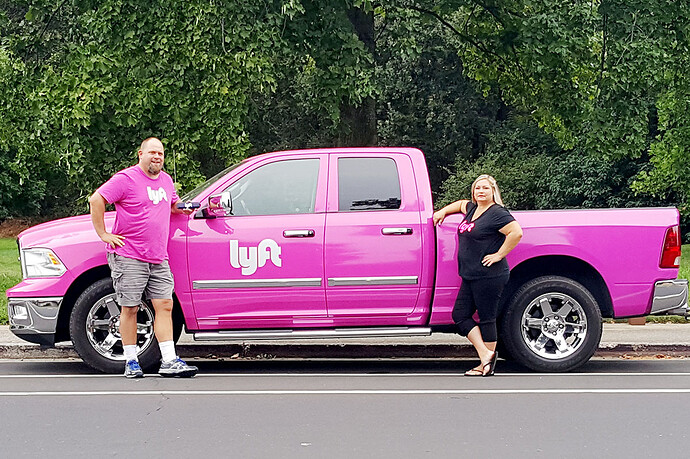Ever since Uber received its wake-up call to stop global expansion and concentrate on national consolidation, Lyft has been feeling the pressure to compete with excellence. During 2017, Lyft enjoyed the vacuum that Uber created with all its global shenanigans. However, it did not truly compete with its bigger brother, it sort of followed after Uber and didn't really make anything new.
This year Lyft has started to work properly, understanding that Uber is back in town, and is concentrating on growing exponentially in the US. With a potential market size of ten times the current levels, both companies have room to grow; the question is how they will grow in comparison to their current ratio.
Lyft Drivers;Sam and Susen Meteer of Sacramento, California
One of the recent modifications that Lyft has come up with and seems to defy the standard business model for rideshare driving is a subscription service. According to Lyft CEO, John Zimmer, the future of US transportation is in shared economy subscriptions, where people pay for rides using different subscription models, just like the mobile service industry offers.
Zimmer told the press that "Eventually, the majority of miles traveled in the United States will be on a network like Lyft. You'll be subscribing to a Lyft transportation plan similar to how you have a music program, maybe Spotify, or a minute's plan like you have on AT&T or Verizon."
According to statistics, Lyft only covers about half a percent of all miles traveled in the US, while Uber covers around 1.1%, so between the two companies they only account for around 1.6% of all US miles being driven. While they will never reach 100%, an immediate target 5% is not too far a target, and it is attainable.
Lyft has two advantages over Uber; the first is their approach and public perception, Uber is considered to be a global villain while Lyft is seen as a white knight. Lyft approaches every step with deliberation, while Uber just charged forward, which basically let Lyft through the front door in the shadow of Uber.
This new subscription model is a game changer, with Lyft emerging from the shadow of Uber, it is starting to make a statement that could accelerate its advance in the US market.
Subscription Basics
Lyft's subscription service is not available in 30 markets across the US.
Packages include:
- Standard Plan with 30 Lyft rides for $199 a month (The rides cannot exceed $15 each)
- All Inclusive Plan with 60 Lyft Rides for $399 a month (The rides cannot exceed $15 each)
There is another option for $300, but no details are available yet.
Subscription Pros
Charging customers on a monthly basis generates a standard income with a limited and metered expenditure that the company can price without the hassle. Subscriptions basically generate a standard income that can act as a backbone for daily income.
Subscription Cons (Literally a con)
Usually, subscriptions are considered to be economically sound, and Lyft pay's drivers based on the actual fare and not the subscription rate. This means that if a customer rides for under $15, the driver will make the same amount of money that they would normally make, and Lyft would earn a monthly $199 for 30 rides, which means that if a customer rides 30 rides at $10 a ride, they should cost $300. The driver will make the usual income on this since Lyft cannot break its contract with the driver just because it wants to lose a few billion bucks.
Bottom Line
Do the math, Lyft has not learned from Uber's mistakes. It is trying to take on a larger portion of the market by offering subsidized rides at a rate that would bankrupt a small nation within a week. Just by looking at these figures and considering what the costs would be, if an average ride is $10, and Lyft takes 20% that means the driver will earn $8 per ride. The subscription is for $199, so if Lyft pays its drivers $8 a ride on average, that means the total cost for Lyft will be $240, which is a $41 loss per month per driver. This translates to a subsidy of $12 million a month if all 315,000 Lyft drivers would work with subsidies.
Now, this might sound like a cheap change for Lyft when considering the billions, they have raised, and have I cash reserves. In effect, it is, but the boomerang effect is when they have to raise prices to stop subsidizing rides and stop cheating taxi services out of business. Why? Because Lyft has to make money, not lose it. They have to rely on income generated from rides. On the other side of the coin, this is a brilliant idea, because it will cause riders to consider joining Lyft without the need to compare prices against Uber or other options.
Once Lyft has reached a level of competitive integrity it will most probably restructure its business model again.
To sum up in Zimmer's own words "In the early days, people misunderstood our kindness as a weakness. We are aggressive but in our own way. We are aggressively working to treat people right, aggressively working to win."
Or as I put it, "it's easier to kill flies with honey than to swat them."

